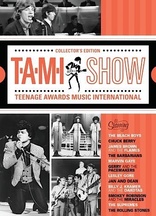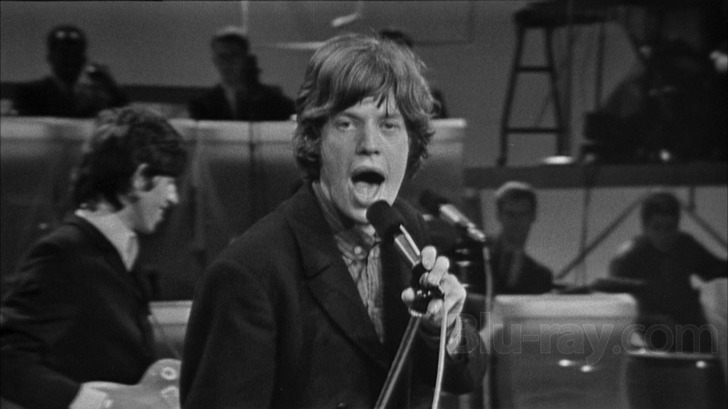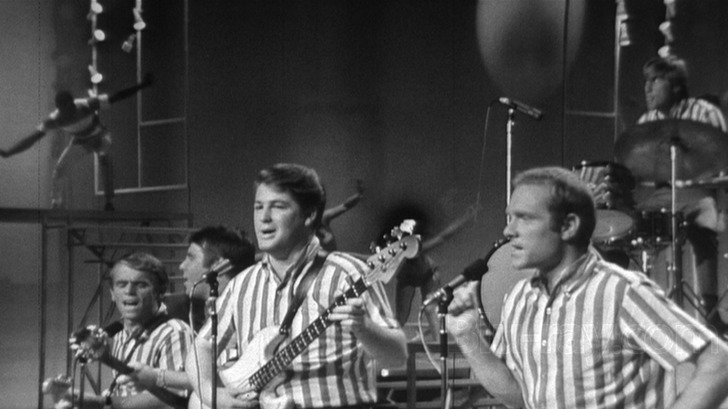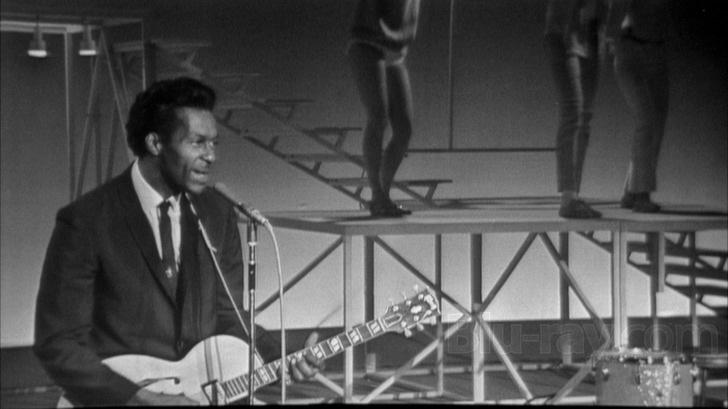The T.A.M.I. Show Blu-ray Movie
HomeThe T.A.M.I. Show Blu-ray Movie 
Shout Factory | 1964 | 112 min | Not rated | No Release Date
Price
Movie rating
7.6 | / 10 |
Blu-ray rating
| Users | 0.0 | |
| Reviewer | 4.0 | |
| Overall | 4.0 |
Overview
The T.A.M.I. Show (1964)
Filmed just eight months after The Beatles appeared on The Ed Sullivan Show, THE T.A.M.I. SHOW introduced rock n soul youth culture to America in the first concert movie of the rock era. One of the rarest and most sought-after performance films from its time, the 1964 concert event featured future Rock and Roll Hall of Famers The Rolling Stones, James Brown, Chuck Berry, The Beach Boys, Marvin Gaye, Smokey Robinson & The Miracles, The Supremes and many other American and British Invasion hitmakers in their prime. This legendary film had not been seen in its entirety since it originally appeared in theaters in 1964. Mastered from a new High Definition transfer and UNCUT, this complete version features the Beach Boys performances that were removed following the films initial theatrical run. Filmed in Electronovision HD at the Santa Monica Civic Auditorium, October 29, 1964
Starring: Mick Jagger, Chuck Berry, James Brown (I), Marvin Gaye, Mike LoveDirector: Steve Binder
| Music | 100% |
Specifications
Video
Video codec: MPEG-4 AVC
Video resolution: 1080p
Aspect ratio: 1.78:1
Original aspect ratio: 1.66:1
Audio
English: DTS-HD Master Audio 2.0
Subtitles
English SDH
Discs
Blu-ray Disc
Single disc (1 BD)
Playback
Region A (B, C untested)
Review
Rating summary
| Movie | 4.0 | |
| Video | 3.0 | |
| Audio | 3.5 | |
| Extras | 3.0 | |
| Overall | 4.0 |
The T.A.M.I. Show Blu-ray Movie Review
Reviewed by Jeffrey Kauffman November 26, 2016Note: This film is available as part of
T.A.M.I. Show / The Big T.N.T. Show.
Horace William Sargent, Jr. may not be a name familiar to many of you, but how can you not love a guy whose obituary in Variety contained
the following memorable tidbit:
His ambitious but often-unrealized schemes included. . .a proposed closed-circuit fight between a man and a great white shark, stopped by the United Nations.In another online tribute to Sargent, a former collaborator of his stated, "He's Mike Todd and P.T. Barnum rolled into one. I have never met a more flamboyant or brilliant promoter," though Sargent never seemed to be able to actually hold on to that vaunted brass ring after he fleetingly grasped it at various times. Sargent (who went by the nickname Bill) was at the forefront of early quasi pay per view events, those these weren’t transmitted to televisions but rather via closed circuit to theaters. Sargent got the bright idea of videotaping live events and then transferring them to film in what for all intents and purposes amounted to that era’s version of a “high definition” kinescope (with over 800 interlaced lines of raw video data, over twice that of “standard” television broadcasts), something that allowed the product to be projected on large screens without much degradation of image quality. Sargent dubbed this technology Electronovision, and debuted his idea with a perhaps intentionally highbrow effort, Richard Burton’s celebrated turn as Hamlet, then a recent Broadway smash hit. Sargent followed up Hamlet with something decidedly more “populist” in nature, a concert video entitled The T.A.M.I. Show, though it’s perhaps indicative of some cracks in Sargent’s ostensible promotional acumen that no one seemed to be able to decide what the acronym T.A.M.I. stood for. The trailer for the film clearly states Teen Age Music International (whatever that means), while other materials proffer Teenage Awards Music International, a definition which perhaps more accurately implies that Sargent’s original conception was an annual concert highlighting the best in youth oriented music. Both the appealing commentary on The T.A.M.I. Show as well as the in depth essay included in the insert booklet with this two disc set (a relative rarity for a Shout! release) detail how Sargent’s failure to manage funds (not entirely his fault) led to the quick demise of Electronovision, at least in its iteration as Electronovision. (For those interested, there is an absolutely fascinating book called Dueling Harlows by Tom Lisanti which documents Sargent’s post-T.A.M.I. attempts to bring his Electronovision version of a biographical film about Jean Harlow out while Joseph E. Levine was prepping another version of Harlow’s tale—with neither “film” doing very well nor it should be added providing anything close to an accurate accounting of Harlow’s life.) The T.A.M.I. Show is often cited as one of the most remarkable concert videos of its era, with a really fascinating blend of acts that includes everyone from Lesley Gore to Gerry and the Pacemakers to James Brown to The Rolling Stones. The concert has had a pretty spotty history on home video, with many bootlegs appearing over the years, often shorn of the performance by The Beach Boys. Shout! released a restored version on DVD, and is now offering the first high definition version of the concert, along with what was for all intents and purposes another Electronovision-ish (for lack of a better word) follow-up, The Big T.N.T. Show, another concert which featured the same videotape to film technology, but without Sargent’s involvement.

Adding to the kind of inadvertent comedy over what exactly T.A.M.I. stands for is the fact that the element utilized for this new Blu-ray actually features the film’s British title, Teen Age Command Performance, which in my estimation probably makes this The T.A.C.P. Show. The opening montage is actually the only part of the show that was shot on film, as discussed by Steve Binder in his commentary. He jokes that the 16mm opening (blown up to 35mm for theatrical exhibition) got critical brickbats at the time of The T.A.M.I. Show’s release as in indication of how “substandard” Electronovision supposedly was.
The montage introduces a number of the major acts who are in the concert, including Jan & Dean, The Supremes, Lesley Gore and James Brown. The actual concert is hosted by Jan & Dean (who also sing), and is an interesting example of ping ponging at times, as in the opening back and forth between Chuck Berry and Gerry and the Pacemakers. As should be expected, the film is a time capsule of who was considered “hot” in mid-1964 (with the obvious exception of The Beatles, who weren’t about to be part of a “compilation” enterprise). Therefore, it may strike some younger viewers especially as a bit odd that now largely forgotten acts like Billy J. Kramer and the Dakotas or The Barbarians share performance time with legends like Marvin Gaye, James Brown and The Rolling Stones. However, it’s important to remember that in mid-1964 Gerry and the Pacemakers were arguably a bigger deal than The Rolling Stones, and acts like Marvin Gaye and even The Supremes hadn’t attained the iconic status that they ultimately would.
The T.A.M.I. Show’s undeniable highlight is the Brown performance, which is like attending a weird kind of revival meeting coupled with a little Vegas excess. It’s actually kind of funny to see The Rolling Stones attempt to follow Brown, and some Stones fans may be shocked to see how absolutely subdued Mick Jagger seems in comparison to the flamboyant Brown.
The show was shot and edited on the fly like a live television performance, but the coverage by Steve Binder and his crew is exemplary. The minimalist stage is filled with a kind of neo-industrial looking set of bleachers and risers on which dancers parade about incessantly (keep an eye out for Teri Garr, who appears throughout).
The T.A.M.I. Show features the following performances:
Jan and Dean: (Here They Come) From All Over the World
Chuck Berry: Johnny B. Goode, Maybellene
Gerry and the Pacemakers: Don’t Let the Sun Catch You Crying, It’s Gonna Be Alright
Chuck Berry: Nadine
Gerry and the Pacemakers: Like It
Smokey Robinson & The Miracles: That’s What Love is Made Of, You’ve Really Got a Hold On Me, Mickey’s Monkey
Marvin Gaye: Stubborn Kind of Fellow, Pride and Joy, Can I Get a Witness, Hitch Hike
Lesley Gore: Maybe I Know, You Don’t Own Me, You Didn’t Look Around, Hey Now, It’s My Party, Judy’s Turn to Cry
Jan and Dean: The Little Old Lady (from Pasadena), Sidewalk Surfin’
The Beach Boys: Surfin’ USA, I Get Around, Surfer Girl, Dance Dance Dance
Billy J. Kramer and the Dakotas: Little Children, Bad to Me, I’ll Keep You Satisfied, From a Window
The Supremes: When the Lovelight Starts Shining Through His Eyes, Run Run Run, Baby Love, Where Did Our Love Go
The Barbarians: Hey Little Bird
James Brown and the Flames: Out of Sight, Prisoner of Love, Please Please Please, Night Train
The Rolling Stones: Around and Around, Off the Hook, Time is on My Side, It’s All Over Now, I’m Alright
The T.A.M.I. Show Blu-ray Movie, Video Quality 

The T.A.M.I. Show is presented on Blu-ray courtesy of Shout! Factory with an AVC encoded 1080p transfer in 1.78:1 (the opening credits sequence, shot on 16mm film, is in 1.66:1, as can be seen from screenshot 19). Occasionally the "edges" of the raw video data can be seen, giving a slightly warped look to the frame (see screenshots 5 and 6 and look at the bottom). Those who have some familiarity with kinescopes may have a generally more favorable reaction to the look of this presentation than those expecting a more traditionally "filmic" look. Both this entry and The Big T.N.T. Show have a perhaps unavoidably "hybrid" quality to the visuals, with video anomalies like black haloing around bright objects and white haloing around dark objects (a by product of the cameras utilized) blending with some fairly heavy and at times noisy looking grain from the film that was ultimately used. Things are fairly soft and not especially well detailed, especially when some "special effects" masking the frame are employed (see screenshots 8 and 9). That said, in moments when the performers are holding relatively still and extreme close-ups are employed, things start to at least approach what some might consider a more typical high definition image (see screenshot 11). There haven't appeared to be any major restorative efforts applied to the elements utilized for this transfer, and so there are manifold speckles, dirt and some pretty serious scratches along the way. Contrast is acceptable if never really well delineated (and it seems to vary from camera to camera at times). Interestingly, the long excised Beach Boy segment boasts generally better clarity than the bulk of the rest of the concert, though the grain field is minimized at least incrementally. My hunch is those who have never seen anything like a kinescope may feel my 3.0 score is too generous, while those more familiar with efforts like this may be willing to cut the video a little more slack than I have.
The T.A.M.I. Show Blu-ray Movie, Audio Quality 

The T.A.M.I. Show features a DTS-HD Master Audio 2.0 mono track that has some age related wear and tear as well as inevitable signs of the recording technologies used at the time, as well as the fact that (according to Don Waller's great liner notes in the insert booklet) the audio was mixed down live in the control room from four track to mono. Pops, cracks and quite a bit of hiss are all evident from the get go, and midrange distortion is frequently heard, especially when performers get too close to microphones (you can hear it clearly when Jan and Dean introduce Chuck Berry and yell a little bit, but it recurs regularly throughout the presentation). All of this said, with an understanding of the provenance of the production, things sound remarkably full bodied in the lower ranges, though there's an unmistakable boxiness to a lot of the proceedings. The mono mix simply can't overcome imbalances due to the incessant (and I mean incessant) screaming of the audience, to the point that some performances are at least momentarily drowned out by the crowd's rambunctious responses. Anyone who has experience with archival audio will be generally pleased with the sound here, while those expecting pristine digital perfection had best readjust their expectations accordingly.
The T.A.M.I. Show Blu-ray Movie, Special Features and Extras 

- Commentary with Director Steve Binder and Music Historian Don Waller is a must listen from any number of standpoints, including the technical data on the shoot as well as fantastic anecdotes about the performers.
- Interview with Director Steve Binder (1080p; 12:36) gets into his general career as well as his relationship with Bill Sargent and involvement with this production.
- Original T.A.M.I. Show Radio Spots
- Spot #1 (1:07)
- Spot #2 (1:05)
- Spot #3 (00:38)
- Spot #4 (00:35)
Note: A little weirdly, none of the timings for the spots shown on stills accompanying each of them match their actual length. - Original Trailer (1080p; 3:38) is also available with a John Landis Commentary (1080p; 4:13) from Trailers from Hell, with Landis' intro in 1:33:1 and the trailer windoboxed.
The T.A.M.I. Show Blu-ray Movie, Overall Score and Recommendation 

While 1964 is understandably now seen as the year The Beatles really took hold of popular music, The T.A.M.I. Show proves what a kaleidoscope of styles was really being enjoyed by young 'uns back in the day. The show is remarkable not just for its commendably integrated cast list, but for the incredibly energetic performances it preserves. This is the rare release whose technical deficiencies don't undermine the worth of the effort, and with an understanding that neither video nor audio approaches contemporary standards, The T.A.M.I. Show comes Highly recommended.
Similar titles
Similar titles you might also like
(Still not reliable for this title)

The Big T.N.T. Show
1966

Led Zeppelin: Celebration Day
2012

Beyoncé: The Beyoncé Experience Live
2007

Britney Spears Live: The Femme Fatale Tour
2011

Elvis Presley
Elvis: '68 Comeback Special - 50th Anniversary Edition
1968

Springsteen & I
Bruce Springsteen
2013

Stop Making Sense
1984

Queen Rock Montreal & Live Aid
1981

Rock & Roll Hall of Fame Concerts
25th Anniversary
2009-2010

Roger Waters: The Wall
2014

Bruce Springsteen & The E Street Band: London Calling: Live In Hyde Park
2009

Roger Waters: Us + Them
2019

Paul McCartney: The Space Within US
2006

Eagles - Hell Freezes Over
1994

Kenny Chesney: Summer in 3D
2010

Green Day: Bullet in a Bible
2005

Roy Orbison: Black & White Night
1987

Joe Bonamassa: Beacon Theatre - Live From New York
2012

Jeff Beck: Performing This Week... Live at Ronnie Scott's
2007

Eric Clapton's Crossroads Guitar Festival 2013
2004-2013